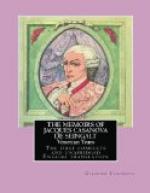In turning over the manuscript at Leipzig, I read some of the suppressed passages, and regretted their suppression; but Herr Brockhaus, the present head of the firm, assured me that they are not really very considerable in number. The damage, however, to the vivacity of the whole narrative, by the persistent alterations of M. Laforgue, is incalculable. I compared many passages, and found scarcely three consecutive sentences untouched. Herr Brockhaus (whose courtesy I cannot sufficiently acknowledge) was kind enough to have a passage copied out for me, which I afterwards read over, and checked word by word. In this passage Casanova says, for instance: ’Elle venoit presque tous les jours lui faire une belle visite.’ This is altered into: ’Cependant chaque jour Therese venait lui faire une visite.’ Casanova says that some one ’avoit, comme de raison, forme le projet d’allier Dieu avec le diable.’ This is made to read: ’Qui, comme de raison, avait saintement forme le projet d’allier les interets du ciel aux oeuvres de ce monde.’ Casanova tells us that Therese would not commit a mortal sin ‘pour devenir reine du monde;’ pour une couronne,’ corrects the indefatigable Laforgue. ’Il ne savoit que lui dire’ becomes ‘Dans cet etat de perplexite;’ and so forth. It must, therefore, be realized that the Memoirs, as we have them, are only a kind of pale tracing of the vivid colours of the original.
When Casanova’s Memoirs were first published, doubts were expressed as to their authenticity, first by Ugo Foscolo (in the Westminster Review, 1827), then by Querard, supposed to be an authority in regard to anonymous and pseudonymous writings, finally by Paul Lacroix, ’le bibliophile Jacob’, who suggested, or rather expressed his ‘certainty,’ that the real author of the Memoirs was Stendhal, whose ’mind, character, ideas and style’ he seemed to recognise on every page. This theory, as foolish and as unsupported as the Baconian theory of Shakespeare, has been carelessly accepted, or at all events accepted as possible, by many good scholars who have never taken the trouble to look into the matter for themselves. It was finally disproved by a series of articles of Armand Baschet, entitled ’Preuves curieuses de l’authenticite des Memoires de Jacques Casanova de Seingalt,’ in ‘Le Livre,’ January, February, April and May, 1881; and these proofs were further corroborated by two articles of




